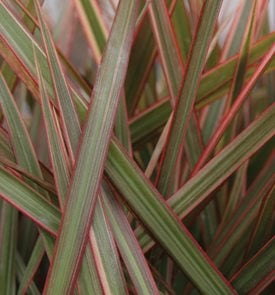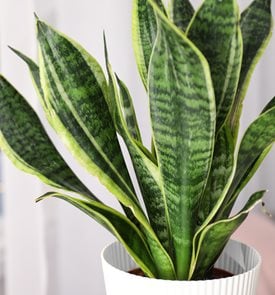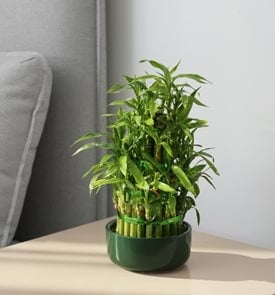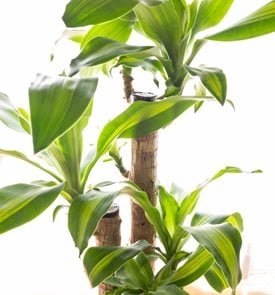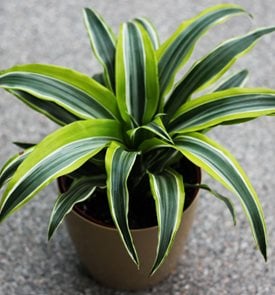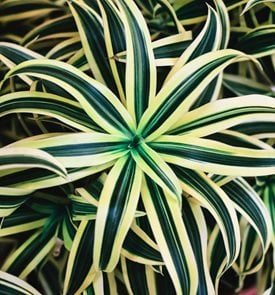HOW TO GROW DRACAENA PLANTS
Grow this versatile, low-maintenance, easy-to-grow, plant in your home, office, or landscape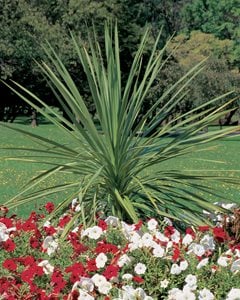
Proven Accents® Spikes (Dracaena indivisa). Photo by: Proven Winners
For beginning gardeners, one of the easiest plants to grow is dracaena. This large group of tropical plants is especially forgiving of low light and other challenging indoor growing conditions, and they can also be grown outdoors (some hardy down to Zone 7). Dracaena grows as a large tree in its native habitat, occurring in shrubby or tree-like forms. The long sword-shaped foliage comes in an array of green, gold, and variegated colors.
Categorization within this genus can be somewhat confusing, with some species overlapping. Dracaena is commonly mistaken for Cordyline, while the popular snake plant Sansevieria was recently reclassified as Dracaena.
On this page: Basics | Growing Tips | Care and Maintenance | Dracaena Pictures | Toubleshooting | Display Ideas
On this page:
- BASICS
- DRACAENA GROWING TIPS
- DRACAENA CARE AND MAINTENANCE
- DRACAENA VARIETIES
- TROUBLESHOOTING
- DISPLAY IDEAS
See more popular indoor plants
BASICS
Botanical name:
Dracaena spp.
Common names:
Dragon tree, corn plant, cornstalk plant, false palm, ribbon plant, money tree
Origin:
Native to Africa, southern Asia, northern Australia and South America
Zones:
USDA zones 9-12, with D. indivisa hardy to USDA Zone 7
Care level:
Easy
Light requirements:
Dracaena prefers bright indirect light, but is tolerant of low light conditions.
Growth rate:
Slow
Foliage:
Smooth spear-shaped or grass-like foliage is solid, striped or speckled, in colors of green, chartreuse, white, pink, red, or gold.
Flowers:
Clusters of star-shaped flowers in colors of white, pink or yellow appear on slender stems. Most varieties rarely blooms indoors. Dracaena fragrans, which is the most likely species to bloom indoors, bears scented flowers.
Habit and size:
Bushy shrub or vertical tree-like form, 6 to 50 feet tall and 3 to 25 feet wide
Toxicity:
Dracaena produces saponins, which are toxic to dogs and cats. Dracaena plants are nontoxic to humans.
Dracaena lookalikes:
- Cordyline: Often mistaken for Dracaena, Cordyline occurs in a wider range of foliage colors including pink, coral, and purple. Cordyline roots are white, while dracaena roots are yellow or orange.
- Yucca: Yucca is hardier and more often grown outdoors. Dracaena leaves tend to be more rigid and the structure is more tree-like than Yucca.
- Aspidistra: The foliage of cast iron plant is wider and more paddle-shaped.
DRACAENA GROWING TIPS
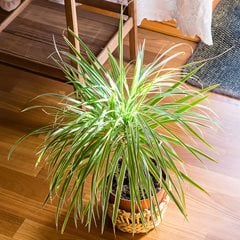
'Song of India' (D. reflexa) Photo by: VadimZosimov / Shutterstock
Where to grow:
Indoors, place near a window that receives at least 2 to 4 hours of bright indirect light. Plants can be placed outdoors in summer in a spot that gets bright indirect light, not direct sun or dark shade.
Temperature:
Ideal daytime temperature range is 65-78 degrees F, with nighttime temperatures ten degrees cooler. Keep away from heating vents or cold drafts. Temperatures below 50-55 degrees F may harm plants.
Humidity:
Dracaena prefers average air humidity between 40-50%. In winter when indoor air is dry, mist foliage once or twice a week, or place pots on a shallow saucer filled with pebbles and water.
Soil type:
Use a high-quality, well-drained potting soil that is well-draining. Dracaenas prefer a slightly acidic soil pH between 6.0-6.5.
Pot requirements:
Choose a pot that is 1 to 2 inches larger than the root ball. Make sure there are adequate drainage holes.
DRACAENA CARE AND MAINTENANCE
Watering:
Keep soil evenly moist and don’t allow soil to dry out. Too much water can cause root rot. Dracaenas are sensitive to tap water that contains fluoride. Water dracaenas with distilled or rainwater.
Fertilizing:
Dracaenas can get by with little fertilizing. Use a water-soluble houseplant fertilizer. Apply once a month during spring and summer. Cease fertilizing in fall and winter when plant growth slows down.
Pruning:
Dracaenas respond well to pruning. Do this during active growth in spring and summer. Trim off damaged leaves and weak growth. Cut back plants to desired shape and size.
Repotting:
Replace top 2 to 3 inches of soil with fresh soil every spring to replenish nutrients without disturbing the roots. Repot in spring every 2 to 3 years. Use a container 1 to 2 inches larger than the previous pot. Remove plant from pot, brush out old soil and gently tease out roots. Add fresh soil, placing the top of the root ball at the same level and water thoroughly.
Pests:
Weakened plants may be more susceptible to pests. These can include spider mites, scale, or mealybugs. Wipe off affected leaves with a cloth dipped in 70% rubbing alcohol. Treat with insecticidal soap as needed.
DRACAENA VARIETIES
TROUBLESHOOTING
- Brown spots or pale, bleached leaves can indicate too much light. Place plants in bright indirect light.
- Slow growth, small new leaves or faded variegation suggests that plants need more light. Move to a bright indirect light source.
- Yellow leaves may be a symptom of overwatering. Reduce watering and make sure pots have adequate drainage.
- Leaves that droop or turn brown on the edges, followed by shriveling, yellowing or browning can be a sign of underwatering. Increase watering and boost air humidity as needed.
- Brown leaf tips can be a sign of low air moisture. Use a room humidifier, mist plants twice a week or place pot on a saucer filled with water and pebbles. Don’t allow pot bottom to stand in water.
- Yellowing of leaf tips or margins, or dead, scorched areas can indicate fluoride sensitivity. Flush soil and water only with distilled or rainwater. Avoid using soil amendments such as perlite or superphosphate, which contain fluoride.
- Browning of leaf tips can indicate overfertilizing. Flush soil and reduce fertilizing.
- Leaf drop can be a sign of overwatering, poor drainage or root rot. Remove plant from pot and inspect roots for damage. Cut out rotted roots and repot in fresh soil. Make sure pot has adequate drainage holes and don’t allow pot to sit in standing water. Reduce watering.
- Blackened or soggy stems are a sign of overwatering, root rot or fungal disease. Discard the entire plant.
DISPLAY IDEAS
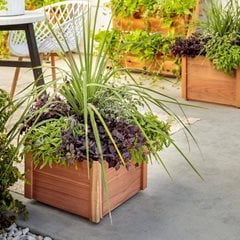
Proven Accents® Spikes (D. indivisa). Photo by: Proven Winners
- Using feng shui principles, place lucky bamboo in an east or southeast area of the home to attract positive energy.
- Group together pots of various sizes, planting them with dracaena and other houseplants with different structure, textures and leaf colors for a contrasting decorative display.
- Use a larger floor specimen to brighten up a living room corner, office lobby or home entryway.
- Repurpose an old wooden step ladder, adding shelves to display dracaenas and other houseplants of contrasting sizes, shapes and colors.
- Place a mountain cabbage tree in a large container outdoors, adding your favorite trailing and filler annuals for a months-long summertime display.
- Plant a smaller specimen in a cheerful pot and place in a kitchen window or on a desktop to enjoy while working.
RELATED:
21 Best Indoor Plants
A Guide to Growing Peace Lily
A Guide to Growing Pothos
